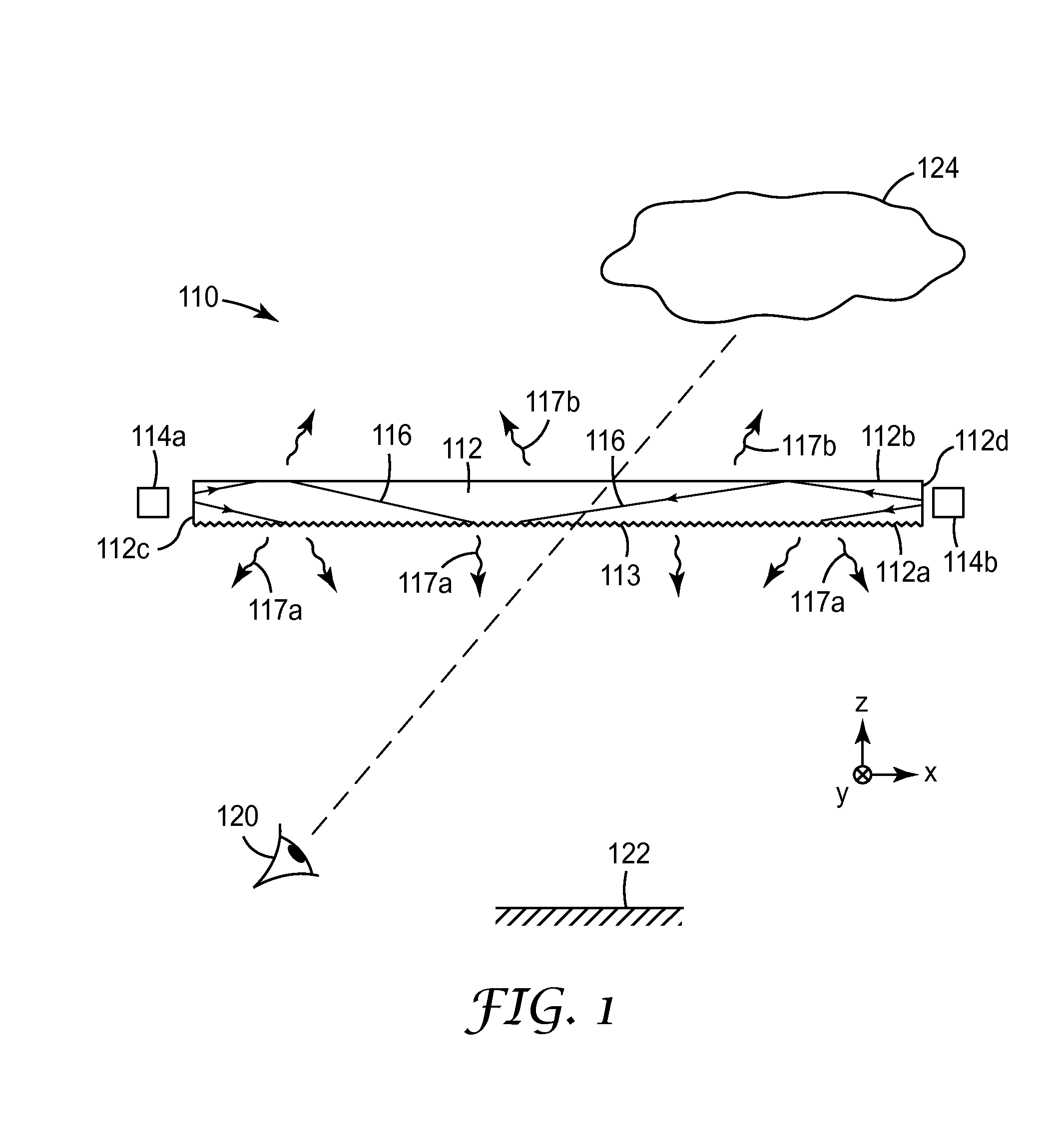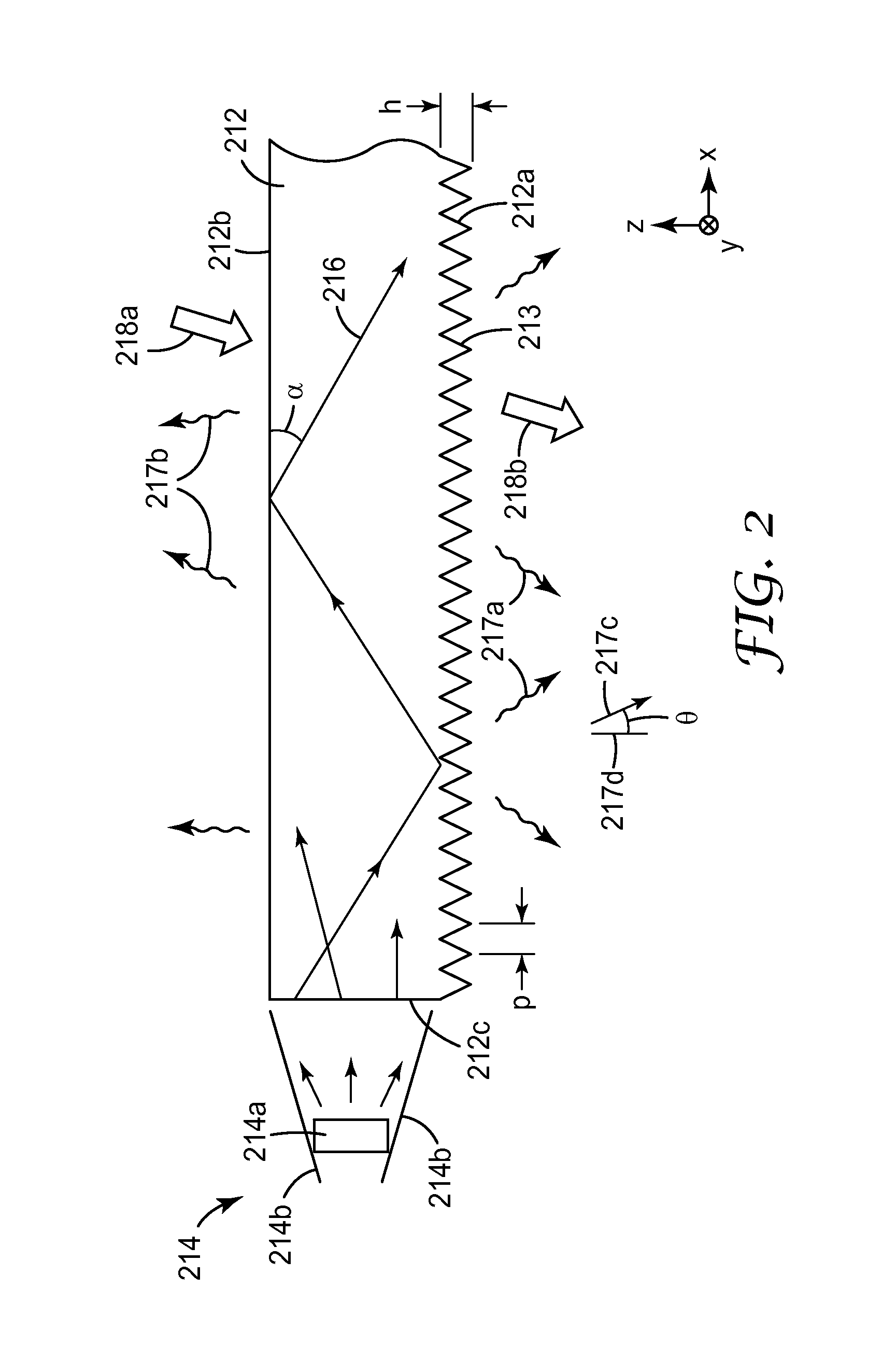Diffractive luminaires
a technology of diffractive luminaires and luminaires, which is applied in the field of diffractive luminaires, can solve the problems of inacceptable color appearance in most end-use applications, and achieve the effect of low optical distortion
- Summary
- Abstract
- Description
- Claims
- Application Information
AI Technical Summary
Benefits of technology
Problems solved by technology
Method used
Image
Examples
example 1
[0200]A lighting device suitable for use as a luminaire was made and evaluated. The device was similar in design to that of FIGS. 12, 12a, and 13. The device incorporated a circular-shaped light guide with diffractive surface features in the form of a spiral pattern, the diffractive surface features arranged into repeating patterns of six packet types with different groove or prism pitches. A mounting ring was used to position thirty-six equally spaced LEDs around the curved side surface of the light guide to inject light into the light guide. Further details of construction will now be given.
[0201]A precision diamond turning machine was used to cut a spiral-shaped groove pattern, which became the diffractive surface features in the lighting device after replication, into the copper surface of a cylindrical tool. The diamond was shaped so that the grooves had a sawtooth (asymmetric) profile in cross section similar to FIG. 6, with a height-to-pitch ratio (see FIG. 6) of about 1:1. D...
example 2
[0215]Another light source was combined with the lighting device of Example 1 to provide a modified lighting device. The additional light source was a conventional flashlight that could be positioned behind the light guide and pointed so as to project light from the flashlight through the light guide as non-guided-mode light, onto reference surfaces of interest. The distortion of the light guide was low, such that light from the flashlight was not substantially deviated by the light guide. The modified lighting device could be controlled such that the LED light sources injecting light into the light guide could be powered “on” while the flashlight was powered “off”, or vice versa, or both the LED light sources and the flashlight could be powered “on” to provide a combined illumination onto reference surfaces of interest.
example 3
[0216]Another lighting device suitable for use as a luminaire was made and evaluated. The device incorporated a rectangular-shaped light guide with diffractive surface features. The diffractive surface features were a portion of the spiral-shaped groove pattern described in Example 1, the portion taken from a central rectangular region of the spiral pattern. A light source module was mounted along one of the short edges of the rectangular light guide, the light source module containing one row of eighteen equally spaced individual, discrete light sources, the light sources being nominally identical LEDs each emitting white light in a divergent distribution. The light guide also incorporated a patterned low index subsurface layer in the form of a random gradient dot pattern. Further details of construction will now be given.
[0217]The following ingredients were combined in a 1-liter wide-mouth amber bottle: 5.70 g of an aliphatic urethane oligomer (product code CN 9893 from Sartomer C...
PUM
 Login to View More
Login to View More Abstract
Description
Claims
Application Information
 Login to View More
Login to View More - R&D
- Intellectual Property
- Life Sciences
- Materials
- Tech Scout
- Unparalleled Data Quality
- Higher Quality Content
- 60% Fewer Hallucinations
Browse by: Latest US Patents, China's latest patents, Technical Efficacy Thesaurus, Application Domain, Technology Topic, Popular Technical Reports.
© 2025 PatSnap. All rights reserved.Legal|Privacy policy|Modern Slavery Act Transparency Statement|Sitemap|About US| Contact US: help@patsnap.com



